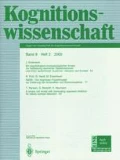Zusammenfassung
Die moderne Logik befaßt sich eher mit der abstrakten Untersuchung der Folgerungsbeziehung, denn mit der mechanistischen Untersuchung des logischen Denkens. Diese abstrakte Sicht bietet viele Vorteile für psychologische Untersuchungen zum schlußfolgernden Denken. Der vorliegende Beitrag gibt einen Überblick über neuere Ergebnisse, die die abstrakte Äquivalenz aller wichtigen psychologischen Kompetenztheorien zum syllogistischen Schließen zeigen. Angesichts der vorliegenden empirischen Daten sind ihre oberflächlich unterschiedlichen Repräsentationsannahmen berechnungsäquivalent. Die wahren, empirisch überprüfbaren Unterschiede zwischen diesen Theorien liegen woanders, nämlich in den Details der Implementierung: ob zum Beispiel integrierte Repräsentationen aufgebaut werden, oder in welcher Reihenfolge diese inspiziert werden. Dies ist aber unabhängig davon, ob eine Repräsentation propositionaler oder bildhafter Art ist oder ein mentales Modell angenommen wird. Logik gibt auch Anhaltspunkte für die Analyse von Repräsentationsanforderungen. Lineare Syllogismen sind durch Zeichenfolgen darstellbar, wohingegen kategoriale Syllogismen im allgemeinen Variablenbindung erfordern. Allerdings folgt aus der hier dargestellten semantischen Analyse, daß alle Kompetenztheorien für kategoriale Syllogismen auf einen Algorithmus hinauslaufen, der die Repräsentation von mehr als einer einzigen Folge vermeidet. Weiter wird erörtert, wie empirisch zwischen möglichen Repräsentationsformaten im Arbeitsgedächtnis beim schlußfolgenden Denken unterschieden werden kann. An Hand der Zweitaufgabentechnik werden grundsätzliche Fragen zur Identifizierbarkeit modalitätsspezifischer Komponenten des Arbeitsgedächtnisses bezüglich sprachlicher und räumlicher Information aufgeworfen. Die sorgfältige Unterscheidung zwischen dem Gedächtnis als Speichermedium und der Interpretation des Gespeicherten führt zu dem Schluß, daß die Interpretation der Gedächtnisinhalte bestimmt, ob es sich um räumliche oder propositionale Information handelt. Als entscheidende Dimension für das Verständnis der Prozesse beim schlußfolgernden Denken wird die Ausdrucksfähigkeit der Interpretation von Repräsentationen herausgestellt.
Abstract
Modern logic is an abstract study of consequence rather than a mechanistic study of reasoning. This abstract view has much to offer psychological studies of the representations which implement human reasoning. This paper reviews recent results showing the abstract equivalence of all the main psychological competence models of syllogistic reasoning. Their apparently contrasting representations are computationally equivalent for the kind of data presented. The true empirical contrasts between theories lie in other details of implementation — in whether integrated representations are constructed and in the sequence of cases considered. These contrasts are independent of sentential, graphical or mental model representation.
Logic is also a guide to representation requirements. Linear syllogism models are representable by sequences of tokens, whereas categorial syllogism models generally require attribute binding. However, one consequence of the present semantic analysis is that all categorial syllogism competence models converge on an algorithm which avoids representation of more than a single sequence.
The paper goes on to consider what evidence could distinguish the representations implementing reasoning in working memory. The example of dual task paradigms is considered and some conceptual questions are raised about the identification of the modalities of working memory subsystems with linguistic and spatial representations. Carefully distinguishing memory medium from memory interpretation leads to the conclusion that it is the interpretation of the contents of memory which determines whether it holds spatial or linguistic information. It is argued that the critical dimension for understanding reasoning processes is the expressiveness of interpretation of representations.
References
Baddeley, A. (1986) Working Memory. Oxford: Oxford University Press.
Baddeley, A. & K. Lieberman (1980) Spatial working memory. Attention and Performance 8, 521–539.
Fodor, J.A. & Z.W. Pylyshyn (1988) Connectionism and cognitive architecture: a critical analysis. Cognition 28, 3–71.
Ford, M. (1995) Two models of mental representation and problem solution in syllogistic reasoning. Cognition 54, 1–71.
Gibson, J.J. (1950) The Perception of the Visual World. Boston, MA: Houghton Mifflin.
Inder, R. (1987) The Computer Simulation of Syllogism Solution Using Restricted Mental Models. PhD thesis, Centre for Cognitive Science, University of Edinburgh.
Johnson-Laird, P.N. (1983) Mental Models. Cambridge: Cambridge University Press.
Stenning, K. & J. Levy (1988) Knowledge-rich solutions to the ‘binding problem’: some human computational mechanisms. Knowledge Based Systems 1(3), 143–152.
Stenning, K. & J. Oberlander (1994) Spatial inclusion and set membership: a case study of analogy at work. In J. Barnden & K. Holyoak (eds.) Analogical Connections (pp 446–486) Hilldsdale NJ: Lawrence Erlbaum Associates.
Stenning, K. & J. Oberlander (1995) A cognitive theory of graphical and linguistic reasoning: logic and implementation. Cognitive Science 19, 97–140.
Stenning, K. & P. Yule (1997) Image and language in human reasoning: a syllogistic illustration. Cognitive Psychology 34, 109–159.
Stenning, K., M. Shepherd & J. Levy (1988) On the construction of representations for individuals from descriptions in text. Language and Cognitive Processes 2(3), 129–164.
Stenning, K., A.W.R. Nelson, J. Levy, M. Patel & M. Gemmell (1992) Representations of individuals and the processing of reference change. Q J Exp Psychol: Human Experimental Psychology 45A(3), 373–398.
Stenning, K., R. Cox & J. Oberlander (1995) Contrasting the cognitive effects of graphical and sentential logic teaching: reasoning, representation and individual differences. Language and Cognitive Processes 10(3/4), 333–354.
Author information
Authors and Affiliations
Corresponding author
Additional information
The work was partly supported by the ESRC funded Human Communication Research Centre.
Rights and permissions
About this article
Cite this article
Stenning, K. Aligning Logical and Psychological Contributions to the Understanding of Human Reasoning. Kognit. Wiss. 7, 39–44 (1998). https://doi.org/10.1007/BF03354962
Published:
Issue Date:
DOI: https://doi.org/10.1007/BF03354962

